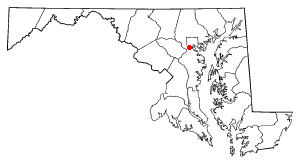Lansdowne-Baltimore Highlands, Maryland
|
|
Lansdowne-Baltimore Highlands is a census-designated place located in Baltimore County, Maryland. As of the 2000 census, the CDP had a total population of 15,724.
| Contents |
History
In the late 1800's the Whitaker Iron Co. mined for ore in Lansdowne. Abandoned pits from the mining were filled up by underground springs creating small ponds and lakes. Lansdowne was mostly farmland including the Kessler farm, MacLeod farm and Wades farm. The name Lansdowne came from the British who named it after the Prime Minister William Petty, the Marquis of Lansdowne.
When the railroad came Lansdowne became known as a B&O town. Most people worked for B&O, commuting by train into Baltimore City. The first station was named Coursey Station. The current Coursey Station senior housing center takes its name from this.
The two main roads were Hammonds Ferry Road and Hollins Ferry Road, both of which led to the Patapsco River where you could take a ferry across to the other side.
Early churches included the Lutheran Church of Our Savior, St. Clement's Catholic Church, Lansdowne United Methodist Church, Lansdowne Christian Churc and the First Baptist Church. The site of the original wooden school house was on the property that is now St. Clement's.
In the area known as Baltimore Highlands is a legendary mansion called English Consul. The land and house were owned by William Dawson, the first English Consul to Maryland. One legend claims that Dawson had a brother who was transported from England to America in disgrace. Each year he was to receive a whip lashing as punishment for the crime he had committed. This took place on the English Consul estate. Another legend has it that the mansion was a stop on the Underground Railroad before the Civil War. In 1909 a developer purchsed the estate. It was eventually divided into the areas known as Baltimore Highlands, Rosemont, Friendship Gardens and the small section still called English Consul.
In the 1950's housing developments sprang up in the Baltimore Highlands and Riverview areas. Schools were built for these neighborhoods. In Lansdowne the Lansdowne Elementary School, Lansdowne Junior High (middle school) and Lansdowne Senior High were known as the "Golden Education Triangle".
In the early 1960's the B&O closed the railroad crossing and Lansdowne Boulevard was constructed, connecting Lansdowne to Washington Boulevard, bridging over the railroad tracks. A tunnel was also constructed under the tracks for pedestrian crossing. Some old railroad cars were erected as a museum and shopping area alongside Hammonds Ferry Road and the railroad tracks.
In the 1980's Baltimore County Recreation and Parks opened a large parcel of land for public use. Southwest Area Park is located on the Patapsco River just below Baltimore Highlands.
A small library was built by Baltimore County in 1966, on Third Avenue. In 1993 the Lansdowne Library was closed due to budget cutbacks. The building is now used as the Southwest Community Center and serves the area's needs for adult education and other county services. In 1989 the Lansdowne/Baltimore Highlands Senior Center was built directly behind the library building.
Source: Baltimore County Public Library
Geography
Lansdowne-Baltimore Highlands is located at 39°14'20" North, 76°39'4" West (39.238782, -76.651246)Template:GR.
According to the United States Census Bureau, the CDP has a total area of 11.1 km² (4.3 mi²). 10.6 km² (4.1 mi²) of it is land and 0.5 km² (0.2 mi²) of it is water. The total area is 4.21% water.
Demographics
As of the censusTemplate:GR of 2000, there are 15,724 people, 5,796 households, and 4,190 families residing in the CDP. The population density is 1,480.7/km² (3,836.8/mi²). There are 6,041 housing units at an average density of 568.9/km² (1,474.1/mi²). The racial makeup of the CDP is 75.70% White, 18.37% African American, 0.36% Native American, 1.86% Asian, 0.03% Pacific Islander, 1.74% from other races, and 1.95% from two or more races. 3.54% of the population are Hispanic or Latino of any race.
There are 5,796 households out of which 39.1% have children under the age of 18 living with them, 42.0% are married couples living together, 24.1% have a female householder with no husband present, and 27.7% are non-families. 21.8% of all households are made up of individuals and 7.7% have someone living alone who is 65 years of age or older. The average household size is 2.71 and the average family size is 3.11.
In the CDP the population is spread out with 29.6% under the age of 18, 10.6% from 18 to 24, 30.4% from 25 to 44, 19.2% from 45 to 64, and 10.3% who are 65 years of age or older. The median age is 32 years. For every 100 females there are 89.5 males. For every 100 females age 18 and over, there are 83.9 males.
The median income for a household in the CDP is $37,160, and the median income for a family is $41,559. Males have a median income of $33,244 versus $22,906 for females. The per capita income for the CDP is $16,348. 13.8% of the population and 12.7% of families are below the poverty line. Out of the total population, 20.6% of those under the age of 18 and 6.7% of those 65 and older are living below the poverty line.

